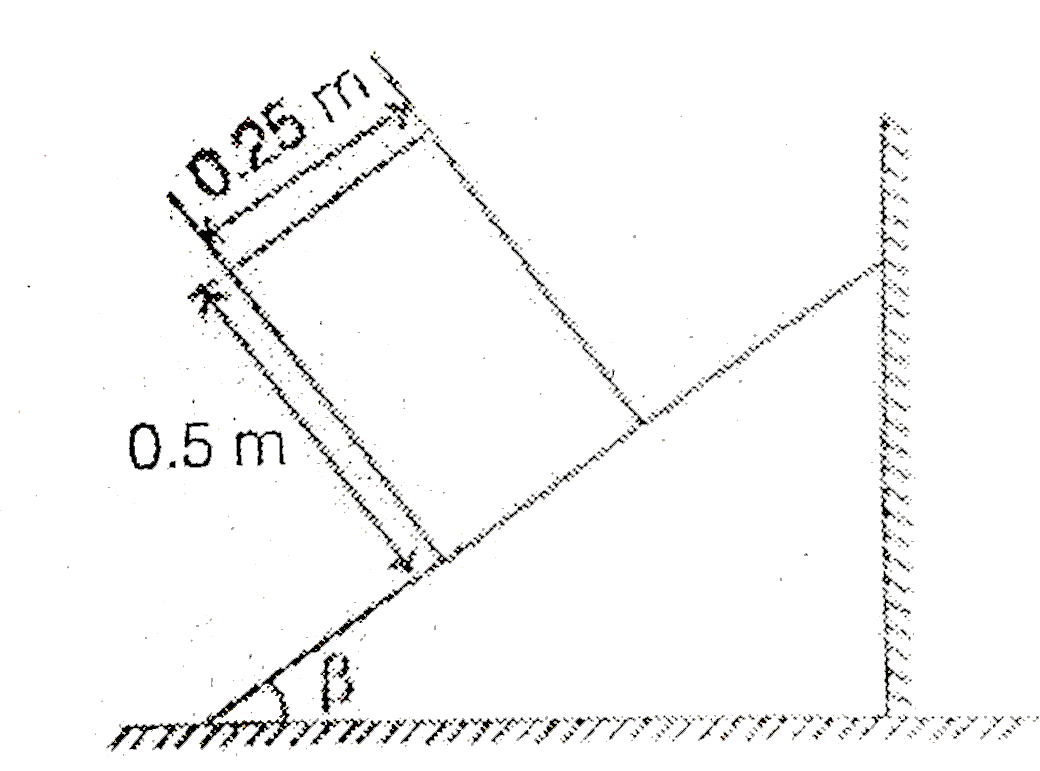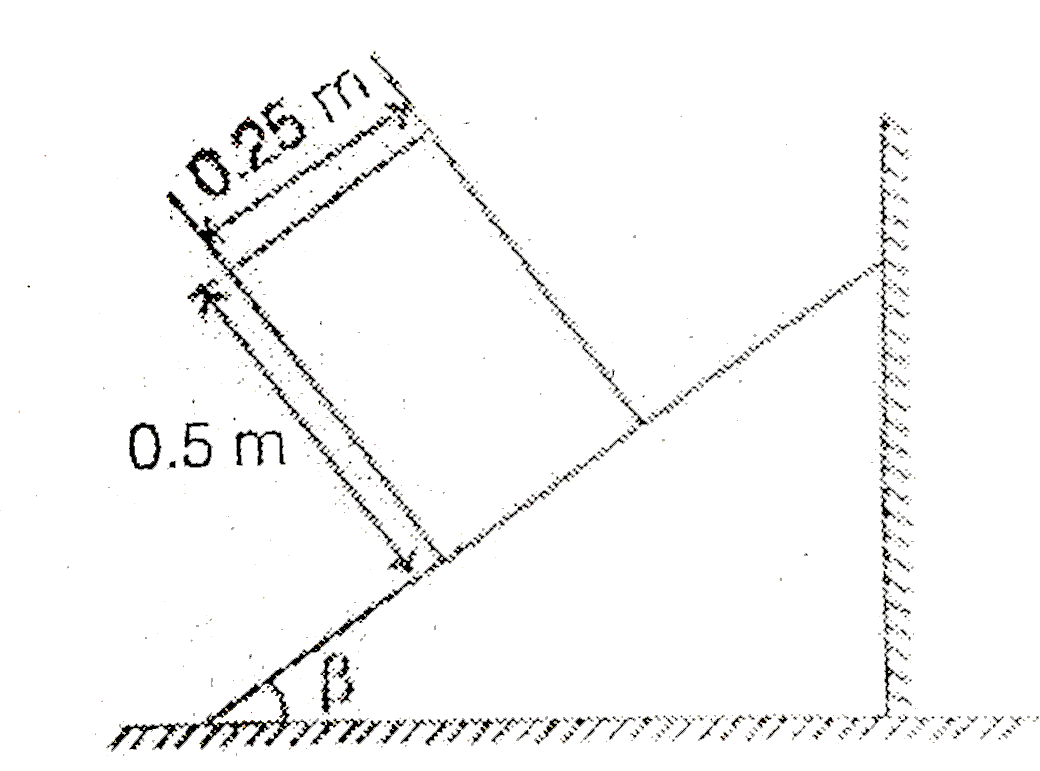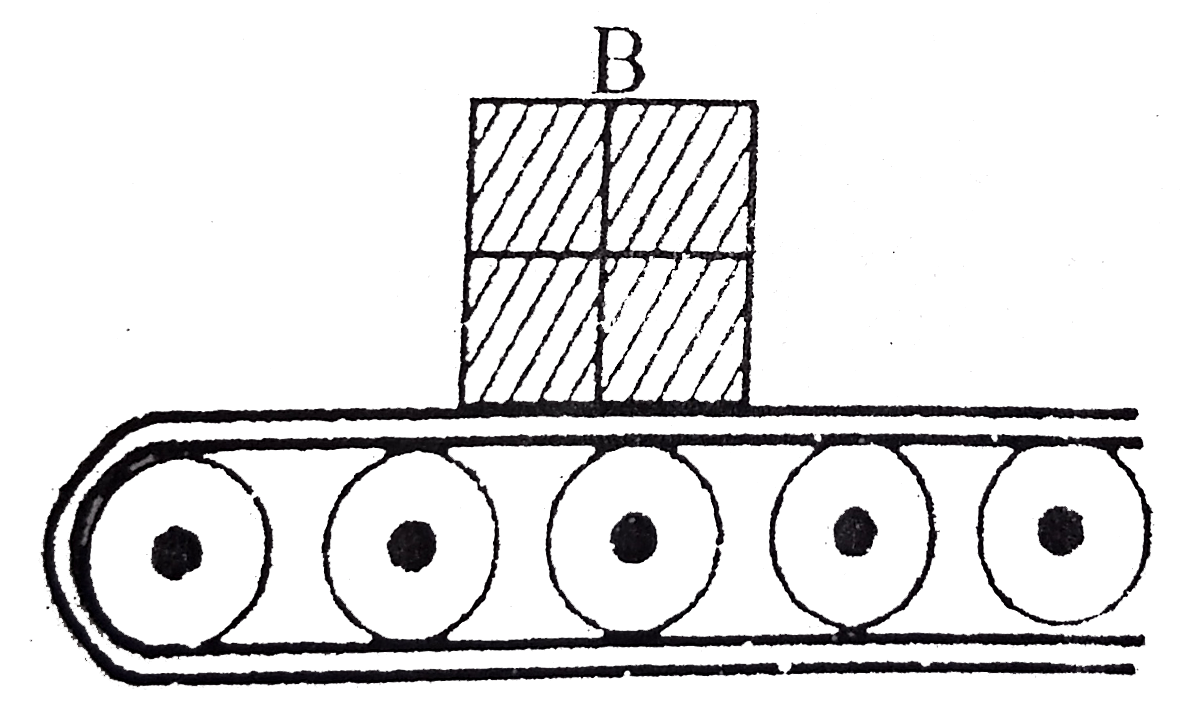An engineer is designing a conveyor system for loading lay bales into a wagon. Each bale is 0.25 m high, and 0.80 m long (the dimension perpendicular to the plane of the figure), with mass 30.0 kg. The centre of gravity of each bale is at its geometrical centre. The coefficient of static friction between a bal and the conveyor belt is 0.60, and the belt moves with constant speed. The angle β of the conveyor is slowly increased. At some critical angle a bale will tip (if it doesn't slip first), and at some different critical it will slip (if it doesn't tip first).

Which statement is correct ?
It will tip first if μs=0.6
It will slide first if μs=0.40
Both are correct
Both are wrong
The correct Answer is:C
Topper's Solved these Questions
- ROTATIONAL MOTIONBOOK - DC PANDEYCHAPTER - ROTATIONAL MOTIONEXERCISE - Matrix Matching Type Questions
17 Videos
- ROTATIONAL MOTIONBOOK - DC PANDEYCHAPTER - ROTATIONAL MOTIONEXERCISE - Integer Type Questions
17 Videos
- ROTATIONAL MOTIONBOOK - DC PANDEYCHAPTER - ROTATIONAL MOTIONEXERCISE - More than one option is correct
36 Videos
- ROTATIONAL MECHANICSBOOK - DC PANDEYCHAPTER - ROTATIONAL MECHANICSEXERCISE - Subjective Questions
2 Videos
- SEMICONDUCTORS AND ELECTRONIC DEVICESBOOK - DC PANDEYCHAPTER - SEMICONDUCTORS AND ELECTRONIC DEVICESEXERCISE - More than One Option is Correct
3 Videos
Similar Questions
An engineer is designing a conveyor system for loading lay bales into a wagon. Each bale is 0.25 m high, and 0.80 m long (the dimension perpendicular to the plane of the figure), with mass 30.0 kg. The centre of gravity of each bale is at its geometrical centre. The coefficient of static friction between a bal and the conveyor belt is 0.60, and the belt moves with constant speed. The angle β of the conveyor is slowly increased. At some critical angle a bale will tip (if it doesn't slip first), and at some different critical it will slip (if it doesn't tip first).

Find the first critical angle (In the same conditions ) at which it tips.
View SolutionAn engineer is designing a conveyor system for loading lay bales into a wagon. Each bale is 0.25 m high, and 0.80 m long (the dimension perpendicular to the plane of the figure), with mass 30.0 kg. The centre of gravity of each bale is at its geometrical centre. The coefficient of static friction between a bal and the conveyor belt is 0.60, and the belt moves with constant speed. The angle β of the conveyor is slowly increased. At some critical angle a bale will tip (if it doesn't slip first), and at some different critical it will slip (if it doesn't tip first).

Find the second critical angle (in the same conditions ) at which it slips.
View Solution
Knowledge Check
An engineer is designing a conveyor system for loading lay bales into a wagon. Each bale is 0.25 m high, and 0.80 m long (the dimension perpendicular to the plane of the figure), with mass 30.0 kg. The centre of gravity of each bale is at its geometrical centre. The coefficient of static friction between a bal and the conveyor belt is 0.60, and the belt moves with constant speed. The angle β of the conveyor is slowly increased. At some critical angle a bale will tip (if it doesn't slip first), and at some different critical it will slip (if it doesn't tip first).

Find the first critical angle (In the same conditions ) at which it tips.Aβ=tan−1(0.50)Bβ=tan−1(0.60)Cβ=tan−1(0.40)Dβ=tan−1(0.20)An engineer is designing a conveyor system for loading lay bales into a wagon. Each bale is 0.25 m high, and 0.80 m long (the dimension perpendicular to the plane of the figure), with mass 30.0 kg. The centre of gravity of each bale is at its geometrical centre. The coefficient of static friction between a bal and the conveyor belt is 0.60, and the belt moves with constant speed. The angle β of the conveyor is slowly increased. At some critical angle a bale will tip (if it doesn't slip first), and at some different critical it will slip (if it doesn't tip first).

Find the second critical angle (in the same conditions ) at which it slips.Aβ=tan−1(0.50)Bβ=tan−1(0.60)Cβ=tan−1(0.12)Dβ=tan−1(0.70)A block is gently placed on a conveyor belt moving horizontal with constant speed After t=4s the velocity of the block becomes equal to velocity of the belt If the coefficient of friction between the block and the belt is μ=0.2, then the velocity of the conveyor belt is .
A8/sB6m/sC4m/sD2m/s
A block is gently placed on a conveyor belt moving horizontal with constant speed After t=4s the velocity of the block becomes equal to velocity of the belt If the coefficient of friction between the block and the belt is μ=0.2, then the velocity of the conveyor belt is .
View SolutionA suitcase is gently dropped on a conveyor belt moving at 3ms−1 If the coefficient of friction between the belt and suitcase is 0.5 how far will the suitcase move on the belt before coming to rest ?
View SolutionA suitcase is gently dropped on a conveyor belt moving at 3m/s. If the coefficient of friction between the belt and the suitcase is 0.5. Find the displacement of suitcase relative to conveyor belt before the slipping between the two is stopped (g=10m/s2)
View SolutionThe conveyed belt is moving at 4m/s the coefficient of static friction between the conveyed belt and the 10kg package Bis mu_(s)=0.2 determine the shortest time in which the belt can be stopped so the the package does not slide on the belt

View SolutionA suitcase is gently dropped on a conveyor belt moving at 3m/s. If the coefficient of friction between the belt and the suitcase is 0.5. Find the displacement of suitcase relative to conveyor belt before the slipping between the two is stopped (g=10m/s2)
View Solution
